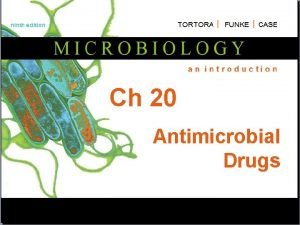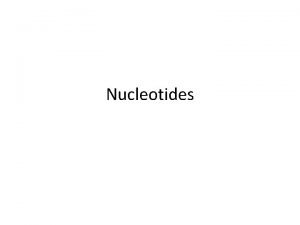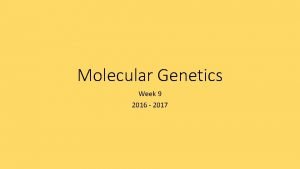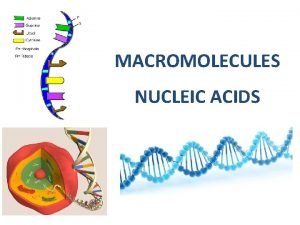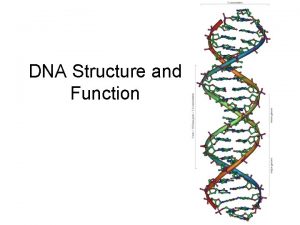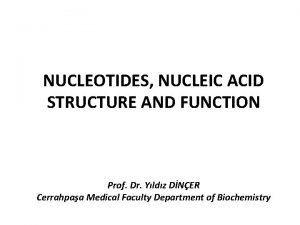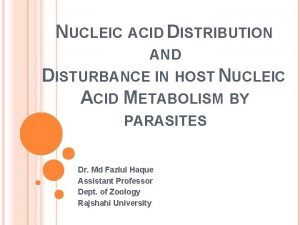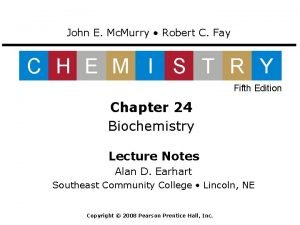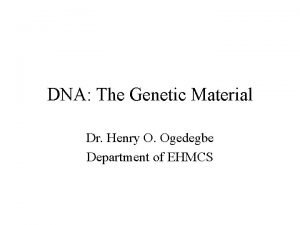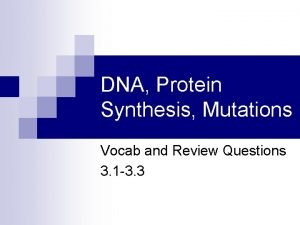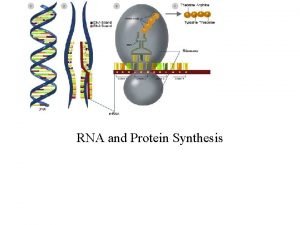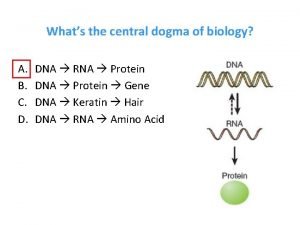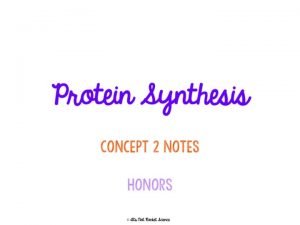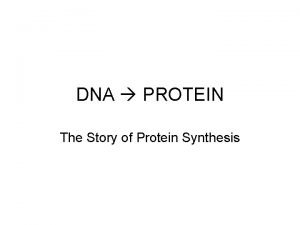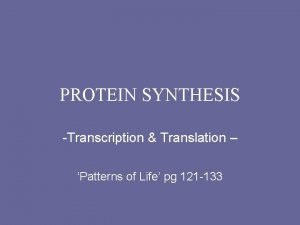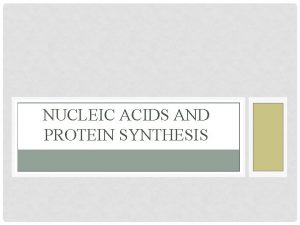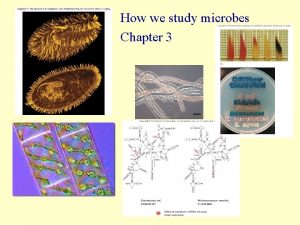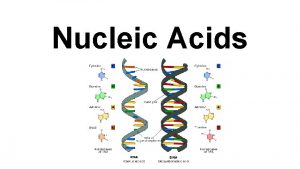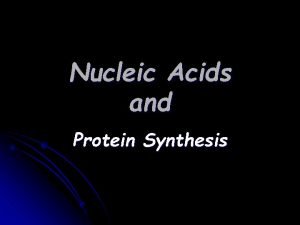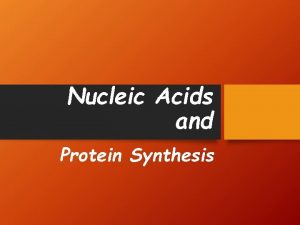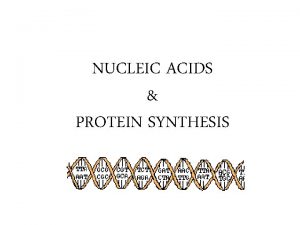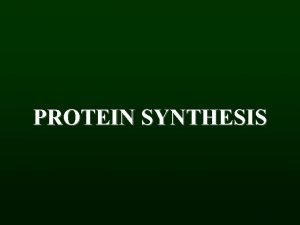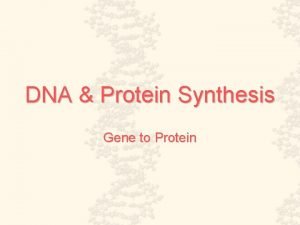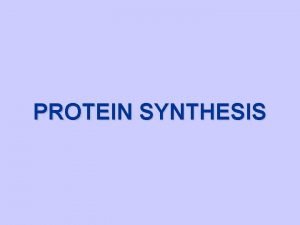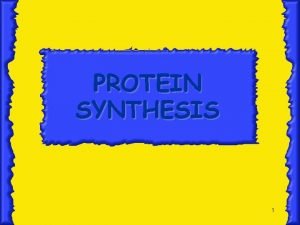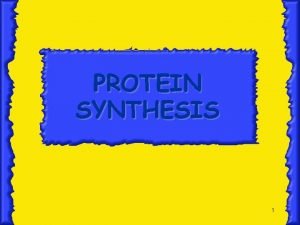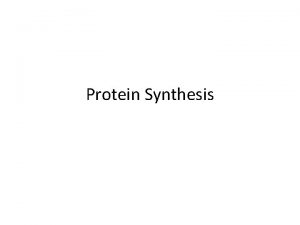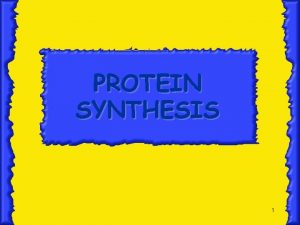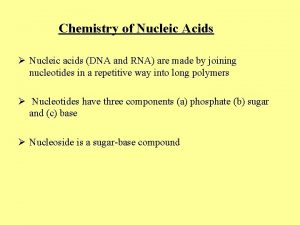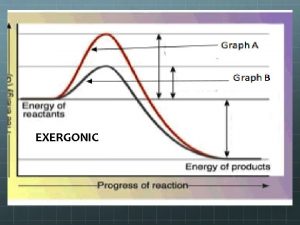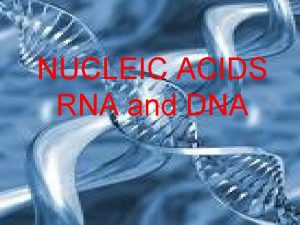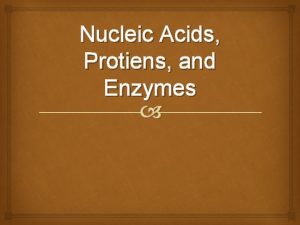10 Nucleic Acids and Protein Synthesis Nucleic acids




































- Slides: 36

10 Nucleic Acids and Protein Synthesis

Nucleic acids are created from subunits called: nucleotides

The three parts to a nucleotide are: Phosphate group, nitrogen base, sugar Phosphate base sugar

Deoxyribose DNA The sugar is _____in Ribose RNA ____in Phosphate base sugar

The bases are Guanine, _______in DNA Cytosine Adenine , Thymine _______ Guanine, Cytosine and ________ Adenine , Uracil ________ in RNA Phosphate base sugar

DNA structure looks like a spiral staircase which is called a: Double Helix

RNA is different because it is only: Single Stranded

DNA can do two things: 1. Replicate- make an exact copy for more cells 2. Direct production of proteins that determine how organisms look and function

RNA has one job: To take the DNA message and bring it to the cytoplams where proteins are Made from it.

A portion on a DNA molecule that contains genetic information is called a: gene

These are later copied and used to create: proteins

These macromolecules are created by connecting_______ using polypeptide bonds: Amino acids

Below is a DNA sequences of nitrogenous bases. Below it write the corresponding nitrogenous base for the other side of the DNA Molecule: ACTGGCCTAGGCTA TGACCGGATCCGAT

RNA is different from DNA because instead of the nitrogenous base ____ found on DNA, RNA has the nitrogenous base_____: Thymine; Uracil

Below is the DNA sequence. Below it write the corresponding bases for a RNA molecule: ACTGGCCTAGGCTA UGACCGGAUCCGAU

There are three types of RNA. They are: a. m. RNA b. t. RNA c. r. RNA

Match the function/description for each type of RNA: r. RNA ______Makes up part of the ribosome; allows for the m. RNA to attach to the ribosome and begin Translation when the ribosome starts to read codons. m. RNA _____The RNA copy of the DNA in the nucleus; leaves to go to the cytoplasm and attach to a ribosome. ____ Carries the correct amino acid to the m. RNA t. RNA during translation; has the anticodon.

m. RNA ____ Made up of codons (groups of three bases) that code for a specific amino acid. t. RNA _____ Contains an anticodon ( the complement to the codon) that allows it to attach to the m. RNA/ribosome during translation.

Protein Synthesis is made up of two steps. Below list the two steps and where each occurs in the cell and summarize the events: Name Location What happens? nucleus -DNA separates - RNA bases added -RNA comes off the. DNA, goes to the cytoplasm Cytoplasm on a ribosome -attaches to a ribosome -Ribosome “reads” codons -t. RNA brings over the correct amino acid -Amino acids linked to make a protein Transcription Translation

Put the following in the correct order of appearance in Protein Synthesis: DNA, m. RNA, ribosome, codon, t. RNA, anti -codon, amino acid, protein

DNA Transcription Replication RNA Translation PROTEIN

How you look= PROTEIN PHENOTYPE TRAITS What genes you have= GENOTYPE

Mutations are any change in the genetic code: 1. DNA may not replicate properly and the incorrect base attached 2. There may be a mistake in transcription 3. There may be a mistake in translation 4. There may be too many or too few chromosomes ( occurs in Meiosis) 5. Parts of chromosomes may be added or deleted …. there are many causes and types of mutations

Practice Questions

1. Look at the DNA sequence below: GAA TTC GCA What do the G and A represent in the DNA sequence? a. sugars b. amino acids c. phosphates d. nitrogen bases

2. How many nucleotides are needed to code for one amino acid? a. 1 b. 3 c. 4 d. 6

3. Which of these results when one nitrogen base replaces another in a segment of genetic material? a. an enzyme substrate b. a mutation c. a feedback loop d. an adaptation

4. Which is the compliment the following DNA AGC-TAC-ACT? a. UCGAUGUGA b. AGCTACACT c. TCGATGTGA d. TCACATCGA

5. A researcher recently discovered a species of bacteria. DNA sequences were obtained from it and form several other species of bacteria. The DNA sequences came from the same part of the bacterial chromosome of each species. Unknown Species ACT GCA GCC Species I ACA GCG CCG Species II ACT GGC Species III ACA GCC GGG Species IV ACT GCA GCG According to the data above, the unknown bacteria are most closely related to which species? a. Species I b. Species II c. Species III d. Species IV

6. During cell replication, an error may result in a base pair substitution. Which of these terms describes the change in base pair sequence? a. Cloning b. Meiosis c. Mutation d. translation

7. Which of these describes a mutation that can be inherited? a. Random breakage in a liver cell’s DNA b. Abnormal lung cells produced by toxins in smoke c. A nitrogen base substitution in a gamete cell d. Ultraviolet radiation damage to skin cells

8. Which of these are the repeating units that form a DNA molecule? a. Fatty acids b. Nucleotides c. Amino Acids d. Chromosomes

9. Hemoglobin is an important protein in red blood cells. The DNA code for hemoglobin contains the following segment: TGC – GGA – CTC Which of these is the messenger RNA code for this segment of DNA? a. ACG-CCT-GAA b. TCC-GGT-CTC c. ACG-CCU-GAG d. UGC-GGA-CUC

10. Which is a not true of the difference between DNA and RNA? a. DNA is double stranded and RNA is single b. DNA has thymine and RNA has Uracil c. DNA and RNA can replicate d. DNA codes for m. RNA which in turn codes for proteins

11. What organelle is necessary for protein synthesis? a. mitochondria b. ribosome c. vacuole d. cell membrane

12. What are the repeating units of all proteins? a. enzymes b. amino acids c. nucleotides d. monosaccharides
 Penicilloic acid
Penicilloic acid Biomedical importance of nucleotides
Biomedical importance of nucleotides Hydoxyle
Hydoxyle What is an anticodon
What is an anticodon The building block of nucleic acids.
The building block of nucleic acids. Polymer structure of nucleic acids
Polymer structure of nucleic acids Nucleic acid function
Nucleic acid function Dna rna
Dna rna Pentose sugar structure in dna
Pentose sugar structure in dna Functions of nucleic acids
Functions of nucleic acids Nucleic acids
Nucleic acids Nucleic acid
Nucleic acid How are macromolecules separated or digested
How are macromolecules separated or digested Nucleic acids
Nucleic acids Features of nucleic acid
Features of nucleic acid Section 12 3 rna and protein synthesis
Section 12 3 rna and protein synthesis 4 steps of protein synthesis
4 steps of protein synthesis Protein synthesis and mutations
Protein synthesis and mutations Protein synthesis and mutations
Protein synthesis and mutations Dna rna and protein synthesis study guide
Dna rna and protein synthesis study guide Section 12 3 rna and protein synthesis
Section 12 3 rna and protein synthesis Totipotent cells
Totipotent cells Messenger rna codons
Messenger rna codons Cell restaurant analogy
Cell restaurant analogy Translation
Translation Transcription and translation bbc bitesize
Transcription and translation bbc bitesize Cookie monster analogy
Cookie monster analogy Whats the central dogma of biology
Whats the central dogma of biology Rna types
Rna types Protein synthesis
Protein synthesis Protein synthesis
Protein synthesis Protein synthesis story
Protein synthesis story Protein synthesis animation mcgraw hill
Protein synthesis animation mcgraw hill Pap protein synthesis worksheet
Pap protein synthesis worksheet Translation biology
Translation biology Protein synthesis
Protein synthesis Protein synthesis
Protein synthesis
